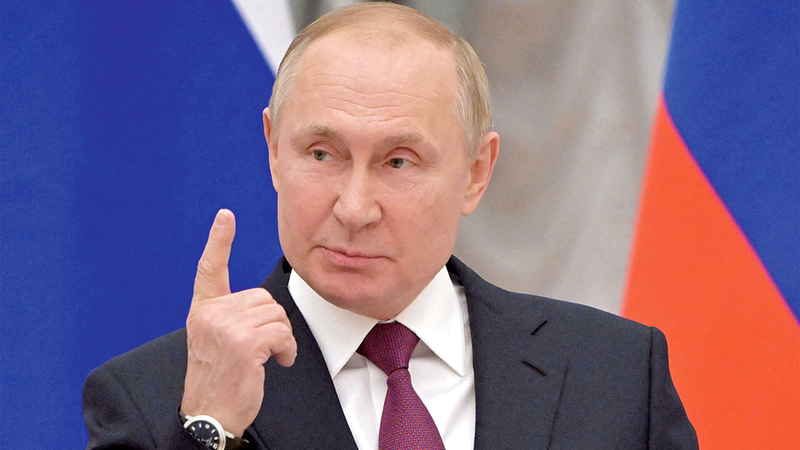
We are still in the early days of the war in Ukraine, but so far the nuclear issues have received more attention than expected. A strategic missile maneuver was a precursor to war. At the start of the Russian military operation, Russian President Vladimir Putin warned that any country that stood in Russia’s way would face “unprecedented consequences in its history.”
Perhaps most alarmingly, Putin instructed his defense minister and head of the civil service to step up the readiness of Russia’s defense forces under a “special regime for war duties”; It is not clear what he said. U.S. defense officials said it was not a word in a well-known functional vocabulary, and that they did not see “real movement” in the context of the Russian nuclear arsenal.
The Russian Defense Ministry has confirmed that its nuclear missile forces and its navy in the North and Pacific are engaged in an “enhanced” combat mission. And some reports say Russia is increasing the number of workers at its nuclear sites, which means all holidays have been canceled. These developments are seen as a difficult time for nuclear strategists. Nuclear signals from the war in Ukraine that we have not seen since the days of the Cuban Missile Crisis. Naturally, this sparked speculation on social media about the possibility of a nuclear conflict, either intentionally or accidentally.
Cases for seeking nuclear option
In early June 2020, Russia released the official outline of its basic principles for nuclear non-proliferation. The document lists four instances of Russia using nuclear weapons, namely:
First, in response to the use of nuclear weapons and other weapons of mass destruction against it or its allies.
– Second, in the event of an aggression against the Russian Federation using conventional weapons, when the existence of the state is in danger.
– Third, when there is reliable information about the launch of ballistic missiles to attack the territory of the Russian Federation or its allies.
Finally, if the enemy attacks important government or military bases in the Russian Federation, disabling them would undermine the nuclear response options.
Some of Putin’s comments suggest an attempt to present arguments under the second section of those rules. The transfer of legacy military equipment dangerous to Ukraine from NATO members and other countries can certainly not be seen as “aggression” in Washington, the European capital or Canberra, at a time when the regime and its supporters are undergoing major sanctions. Or endanger the existence of the Russian state. It is true that some commentators believe that these actions threaten the future of the Putin regime, but most of them see them as mere moves against Moscow to change its course towards Ukraine.
Rude
More recently, however, Putin’s behavior has been different, including his long-distance sit-ins; The long list of perceived grievances was driven by a burning ambition and wounded pride to re-establish a great Russia. This means, of course, that the probability of increase is greater than the probability of decrease.
Does this expansion include nuclear weapons?
Yes. But since the days of the Cold War, Western intelligence may still have a good list of warning signs of impending nuclear use. I think we are not close to that.
It is noteworthy that Putin has many other opportunities. Options include overthrowing the current government in Kiev and establishing a more consistent regime instead; Ukraine was then gradually reunited under Moscow’s control. This is easier said than done, of course, but Moscow has experience in this matter. He may also choose to strike supply lines carrying military equipment to Ukraine – with conventional weapons. Or he may consider a goal again, without resorting to nuclear weapons.
Today, strategic defenses are not limited to conventional and nuclear weapons. Conflict has become a multi-domain. Conventional long-range precision-strike weapons, Internet options and space-based weapons are all possible.
4 cases requiring nuclear deterrence
A document released in 2020 lists four instances of Russia using nuclear weapons:
1. Response to the use of nuclear weapons and other weapons of mass destruction against it or its allies.
2. When the existence of the state is endangered by the use of conventional weapons in the event of an aggression against the Russian Federation.
3. When there is reliable data on the launch of ballistic missiles aimed at the territory of the Russian Federation or its allies.
4. If an enemy attacks important government or military bases in the Russian Federation, their disruption will undermine the nuclear forces’ response options.
Putin’s recent behavior is bizarre, including the test of his long-distance occupants; The long list of perceived grievances was driven by a burning ambition and wounded pride to re-establish a great Russia.
Rod Leon லோ Fellow of the Australian Institute for Strategic Policy
Follow our latest local and sports news and the latest political and economic developments via Google News

“Creator. Award-winning problem solver. Music evangelist. Incurable introvert.”







